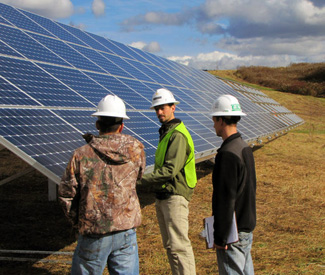

SunCommon’s designers consult on the project. From left to right: Sam Lau, Jacob Flanigan and Chris Houck.
Note: This piece was written by Jamison Ervin of Waterbury LEAP, the town energy committee serving Waterbury and Duxbury and Suncommon’s partner on the Solar for Scholars program.
By now, most travelers along Route 100, and certainly anyone with a student at Crossett Brook Middle School, have seen the new solar array erected this fall next to the school soccer fields. Today, Thursday, Gov. Peter Shumlin, along with Green Mountain Power CEO Mary Powell, Principal Tom Drake, and representatives from SunCommon, Green Lantern and Waterbury LEAP, will officially celebrate by flipping the switch.
The structure, consisting of 480 glass solar panels atop a scaffolding of steel racking, represents a new piece of hardware on our landscape. Although there are no whirring moving shafts, this simple glass and steel structure is indeed a sophisticated engine that packs a powerful punch.
First, this array is an engine of renewable energy. At 157 kilowatts, it is the largest school solar array in Vermont, and provides enough energy to power roughly 30 households. Along with the 14.2-kilowatt array already installed on the roof, this new array will provide more than a third of the school’s annual energy needs from local, non-polluting, renewable resources. Over the lifetime of the array, this is equivalent to the amount of carbon sequestered by 2,700 acres of forest.
Second, this array is an engine of economic investment and savings. Instead of investing their capital overseas or out of state, a local Vermont company has invested $530,000 in this project, right here in Duxbury. This investment enables Waterbury and Duxbury taxpayers to save $300,000 over the lifespan of the project. In addition, taxpayers will save up to $60,000 with the new 32.4-kilowatt array installed this month on the roof of the Main Street Fire Station in Waterbury, as well as $1.2 million with a larger array slated for next year. Similarly, the 80-plus families who have already installed solar at their own homes in Waterbury and Duxbury will each see an estimated average savings of $11,500 per household over the course of 20 years.
Third, this array is an engine of economic growth. Our community already supports more than 70 full-time solar jobs — more than 50 times the national per-capita average. And that’s not all — these new workers are very likely to pick up a case of Heady Topper on their way home, stop in at Blue Stone for a pizza, pick up a gift at Bridgeside Books, Stowe Street Emporium or Proud Flower, and frequent our many locally-owned businesses, strengthening our local economy even further. Furthermore, Waterbury-based solar installers do business with more than 60 local companies, pumping tens of thousands of dollars right back into Central Vermont.
Fourth, this array is an engine for learning, particularly on the topics our children need most in order to secure good jobs in the future — science, technology, engineering and math. Former teacher of the year Sarah Popowicz and Principal Drake are pioneering the state’s first middle-school program on sustainability at Crossett Brook, and are already incorporating the new solar array into this cutting-edge curriculum. Learning about solar and related technology will help our schools inspire and instruct the next generation of engineers, technicians and scientists. If the 2014 “Solar for Scholars” goal is successful, the school will extend this learning to sustainable food systems.
Fifth, and perhaps most importantly, this simple array is an engine for our collective imagination. Duxbury is already second in Vermont for per-capita installed residential and community solar, in a state that ranks ninth in the nation. But this new school solar array signals that we’ve only just begun to change the trajectory of our energy future. This array encourages us and our children to envision and strive for a future that does not depend on foreign oil, or hydraulic fracturing, or mountaintop coal removal, but rather allows us — as a school, community and state — to envision a future that is fully powered by our very own, home-grown, back-yard energy solutions.
Not bad for a simple structure of glass and steel.




